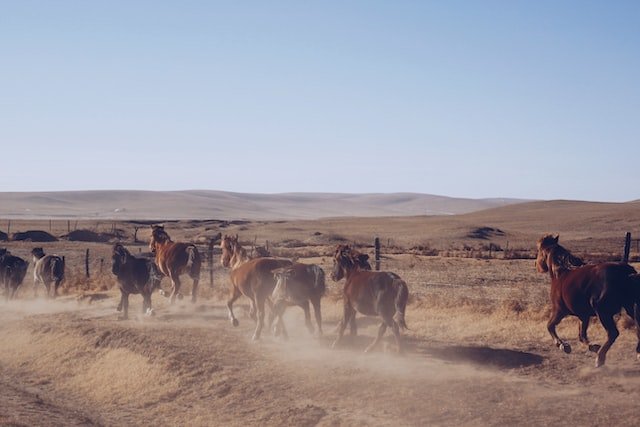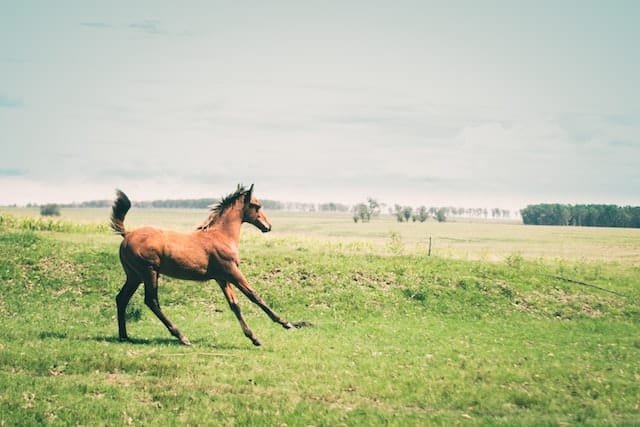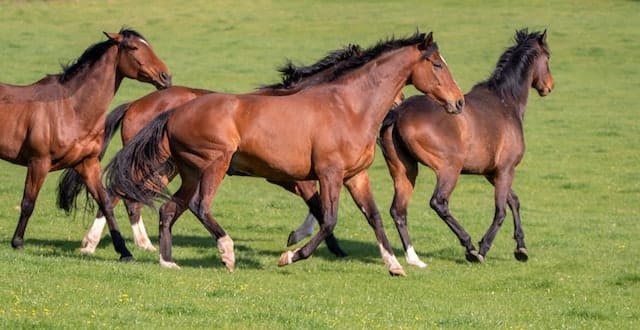A healthy horse that’s in good shape can cover 20 to 25 miles in a day while changing its pace over time. That’s a lot of distance to cover. How can they do it? How can horses run for so long?
The answer lies in how horses evolved and consequently the physiology and anatomy of the modern horse that makes long-distance running possible.
We’ll start this article by first studying why horses are able to run long distances. Then we’ll delve into the ‘How’ by reviewing the horse’s anatomical features including its legs, joints, feet and hooves as well as its respiratory and circulation systems all of which support the horse in long-distance runs.
Evolution: Why Did Horses Need To Run Long Distances
The earliest known ancestor of the modern horse was the Eohippus. The Eohippus lived in forests and was the size of a fox. It did not have a need to run long distances because the forests provided food, shelter and the means to hide from predators.
As the climate changed and the forests started being replaced by grasslands, the Eohippus evolved and went through many iterations before becoming the Equus Caballus or modern horse as we know it today. At each turn, horses adapted to their environment as the environment changed over millions of years.
With the emergence of grasslands came many anatomical changes to the horse. For instance, the horse’s teeth became adapted to grinding grass rather than twigs and leaves. Its intestines became longer so that it could extract more nutrients from the tough grasses. Did you know that horses can even extract protein from grass? This is one of the reasons why horses eat hay and need almost nothing else.
The biggest change, however, was to the horse’s legs. The Eohippus’ short legs were not built for long-distance running. But as the grasslands stretched for miles and miles, the horses that could run the farthest and the fastest had the best chance of survival.
Thus, over time, the horses that could run long distances became more common as they passed on their genes to future generations. This is how evolution built the modern horse into a long-distance runner.
How Can Horses Run For So Long: Because It’s Natural
Horses have a natural instinct to run and they run for many reasons. Chief amongst these are the need to survive, find food and find a mate.
To survive horses had to outrun their natural predators like bears, coyotes and mountain lions. This is one of the reasons why horses are fast runners. Running fast (and not just far) was a requirement for survival.

To find food, horses sometimes needed to cover long distances in search of grazing areas. Especially when competition for food was high and resources were scarce, covering long distances was at times the only way to find food.
In the wild, horses live in herds. And often a part of herd behavior involves a horse leaving the herd. This could be because it is pushed out in a power struggle or because it needs to go elsewhere to find a mate. And this latter reason can mean covering long distances to find another herd and suitable a mate.
Anatomy For Long Distance Running
When it comes to long-distance running, horses have followed the positive feedback loop of evolution. The need to run long distances helped the horse have a body that made it possible to run long distances. And because the horse had the body for it, it started running long distances.
This positive loop is the reason the horse has the anatomy it has today. For instance, the horse’s legs are long which gives it a longer stride. This is an advantage because with each step, the horse can cover more ground and thus run faster.
The horse’s joints are also designed for long-distance running. They are large and strong which helps the horse’s legs bear the brunt of its weight and the impact of each step.
Also, an interesting fact is that the horse has no muscles below the knee. Instead, it has long tendons that connect the knee to the feet. This gives it light legs which is an advantage because it means the horse’s legs can move faster.
The horse’s feet are also key to its long-distance running ability. They are relatively large which helps them distribute the horse’s weight evenly. This is important because it minimizes the impact on the horse’s legs and helps prevent injuries. The horse’s feet are also padded which provides additional cushioning and helps absorb shock.
If you take a close look at your horse’s hoof walls, you’ll notice that they are sloped. They are made from a protein called keratin. This is the same protein that makes up our hair, skin and nails. In fact, the hooves of a horse are like nails for us humans.
The sloping shape of the hooves allows the horse’s weight to be borne by the hoof walls rather than the foot’s sole. This helps protect the sole, allows the horse to go on almost any surface, and run for long distances while protecting the more delicate parts of its legs.
All of these anatomical features work together to allow horses to run for long distances. But there’s another factor that contributes to a horse’s ability to run long distances, and that is its respiratory and circulatory system.
Let’s cover that next.
Respiratory and Circulatory Systems For Stamina And Endurance
Apart from having the muscles and physical structure for long-distance running, the horse also has a respiratory and circulatory system that allows it to run for long periods of time.
The role of the respiratory system is to breathe in air, extract oxygen and pass it into the blood for circulation. In reverse, it also involves taking carbon dioxide from the blood and passing it to the lungs for exhalation.
The role of the circulatory system is to bring oxygen to parts of the body where it is needed. The horse’s spleen stores extra red blood cells for those times when the horse needs a burst of oxygen delivered to its muscles. This can be when a horse is running from a predator and needs extra speed or during a long-distance run.
The Bottom Line
The question – How can horses run for so long – can be tackled from three angles. First, evolution required the horse to run fast and cover long distances. And so it does.
Second, to make long-distance running possible the horse developed the muscles, ligaments, tendons, and joints for it.
And finally, the horse has a respiratory and circulatory system that allows it to run for long periods of time.



